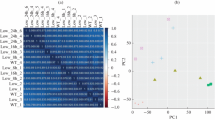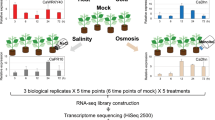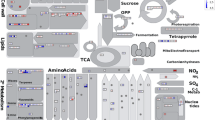Abstract
Background
Bell pepper (Capsicum annuum L.) is one of the most economically and nutritionally important vegetables worldwide. However, its production can be affected by various abiotic stresses, such as low temperature. This causes various biochemical, morphological and molecular changes affecting membrane lipid composition, photosynthetic pigments, accumulation of free sugars and proline, secondary metabolism, as well as a change in gene expression. However, the mechanism of molecular response to this type of stress has not yet been elucidated.
Methods and results
To further investigate the response mechanism to this abiotic stress, we performed an RNA-Seq transcriptomic analysis to obtain the transcriptomic profile of Capsicum annuum exposed to low temperature stress, where libraries were constructed from reads of control and low temperature stress samples, varying on average per treatment from 22,952,190.5–27,305,327 paired reads ranging in size from 30 to 150 bp. The number of differentially expressed genes (DEGs) for each treatment was 388, 417 and 664 at T-17 h, T-22 h and T-41 h, respectively, identifying 58 up-regulated genes and 169 down-regulated genes shared among the three exposure times. Likewise, 23 DEGs encoding TFs were identified at T-17 h, 30 DEGs at T-22 h and 47 DEGs at T-42 h, respectively. GO analysis revealed that DEGs were involved in catalytic activity, response to temperature stimulus, oxidoreductase activity, stress response, phosphate ion transport and response to abscisic acid. KEGG pathway analysis identified that DEGs were related to flavonoid biosynthesis, alkaloid biosynthesis and plant circadian rhythm pathways in the case of up-regulated genes, while in the case of down-regulated genes, they pertained to MAPK signaling and plant hormone signal transduction pathways, present at all the three time points of low temperature exposure. Validation of the transcriptomic method was performed by evaluation of five DEGs by quantitative polymerase chain reaction (q-PCR).
Conclusions
The data obtained in the present study provide new insights into the transcriptome profiles of Capsicum annuum stem in response to low temperature stress. The data generated may be useful for the identification of key candidate genes and molecular mechanisms involved in response to this type of stress.








Similar content being viewed by others
Data availability
Data presented in this study are available on fair request to the corresponding author.
Abbreviations
- DEGs:
-
Differential expression genes
- GO:
-
Gene ontology
- KEGG:
-
Kyoto encyclopedia of genes and genomes
- LT:
-
Low temperature
References
Zhu J, Dong CH, Zhu JK (2007) Interplay between cold-responsive gene regulation, metabolism and RNA processing during plant cold acclimation. Curr Opin Plant Biol 10(3):290–295. https://doi.org/10.1016/j.pbi.2007.04.010
Ji L, Li P, Su Z, Li M, Guo S (2020) Cold-tolerant introgression line construction and low-temperature stress response analysis for bell pepper. Plant Signal Behav 15(7):1773097. https://doi.org/10.1080/15592324.2020.1773097
Doherty CJ, Van Buskirk HA, Myers SJ, Thomashow MF (2009) Roles for arabidopsis CAMTA transcription factors in cold-regulated gene expression and freezing tolerance. Plant Cell 21(3):972–984. https://doi.org/10.1105/tpc.108.063958
Guo X, Liu D, Chong K (2018) Cold signaling in plants: insights into mechanisms and regulation. J Integr Plant Biol 60(9):745–756. https://doi.org/10.1111/jipb.12706
Theocharis A, Clément C, Barka EA (2012) Physiological and molecular changes in plants grown at low temperatures. Planta 235(6):1091–1105. https://doi.org/10.1007/s00425-012-1641-y
Thomashow MF (2010) Molecular basis of plant cold acclimation: insights gained from studying the CBF cold response pathway. Plant Physiol 154(2):571–577. https://doi.org/10.1104/pp.110.161794
Ali MM, Yousef AF, Li B, Chen F (2021) Effect of environmental factors on growth and development of fruits. Trop Plant Biology 14(3):226–238. https://doi.org/10.1007/s12042-021-09291-6
Bakker JC, van-Uffelen AM (1988) The effects of diurnal temperature regimes on growth and yield of glasshouse sweet pepper. Neth J Agric Sci 36(1):201–208. https://doi.org/10.18174/njas.v36i3.16670
Hincha DK, Zuther E (2014) Introduction: plant cold acclimation and freezing tolerance. In: Hincha DK, Zuther E (eds) Plant cold acclimation: methods and protocols. Springer, New York, pp 1–6
Pressman E, Shaked R, Firon N (2006) Exposing pepper plants to high day temperatures prevents the adverse low night temperature symptoms. Physiologia Plantarum 126(4):618–626. https://doi.org/10.1111/j.1399-3054.2006.00623.x
León-Chan RG, López-Meyer M, Osuna-Enciso T, Sañudo-Barajas JA, Heredia JB, León-Félix J (2017) Low temperature and ultraviolet-B radiation affect chlorophyll content and induce the accumulation of UV-B-absorbing and antioxidant compounds in bell pepper (Capsicum annuum) plants. Environ Exp Bot 139:143–151. https://doi.org/10.1016/j.envexpbot.2017.05.006
Airaki M, Leterrier M, Mateos RM, Valderrama R, Chaki M, Barroso JB, Del RÍOLA, Palma JM, Corpas FJ (2012) Metabolism of reactive oxygen species and reactive nitrogen species in pepper (Capsicum annuum L.) plants under low temperature stress. Plant Cell Environ 35(2):281–295. https://doi.org/10.1111/j.1365-3040.2011.02310.x
Morrison N, Cochrane G, Faruque N, Tatusova T, Tateno Y, Hancock D, Field D (2006) Concept of sample in OMICS technology. Omics 10(2):127–137. https://doi.org/10.1089/omi.2006.10.127
Nagalakshmi U, Waern K, Snyder M (2010) RNA-Seq: a method for comprehensive transcriptome analysis. Curr Protoc Mol Biol. https://doi.org/10.1002/0471142727.mb0411s89
Leon R, Lightbourn L, lopez-meyer M, Amarillas L, Heredia J, Martínez-Bastidas T, Villicaña C, León-Félix J (2020) Differential gene expression of anthocyanin biosynthetic genes under low temperature and ultraviolet-B radiation in bell pepper (Capsicum annuum). Int J Agric Biology 23:531–538. https://doi.org/10.17957/IJAB/15.1315
Kong X-m, Zhou Q, Luo F, Wei B-d, Wang Y-j, Sun H-j, Zhao Y-b, Ji S-j (2019) Transcriptome analysis of harvested bell peppers (Capsicum annuum L.) in response to cold stress. Plant Physiol Biochem 139:314–324. https://doi.org/10.1016/j.plaphy.2019.03.033
Ji L, Li P, Su Z, Li M, Wang H (2020) Transcriptome analysis reveals candidate genes involved in low temperature stress in bell pepper. Russ J Plant Physiol 67(6):1116–1125. https://doi.org/10.1134/S1021443720060084
Morales-Merida B, Villicaña C, Perales-Torres A, Martinez Montoya H, Castillo-Ruiz O, Leon R, Lightbourn L, Heredia JB, León-Félix J (2021) Transcriptomic analysis in response to combined stress by UV-B radiation and cold in belle pepper (Capsicum annuum). Int J Agric Biol. https://doi.org/10.17957/IJAB/15.1753
Zhang J, Liang L, Xie Y, Zhao Z, Su L, Tang Y, Sun B, Lai Y, Li H (2022) Transcriptome and metabolome analyses reveal molecular responses of two pepper (Capsicum annuum L.). Cultivars Cold Stress. https://doi.org/10.3389/fpls.2022.819630
Rodriguez A, De La Vega P (2021) Tallos (stems). Crabtree Publishing Company, St. Catharines
Cohen SP, Leach JE (2019) Abiotic and biotic stresses induce a core transcriptome response in rice. Sci Rep 9(1):6273. https://doi.org/10.1038/s41598-019-42731-8
Yang G, Wang Y, Zhang K, Gao C (2014) Expression analysis of nine small heat shock protein genes from Tamarix hispida in response to different abiotic stresses and abscisic acid treatment. Mol Biol Rep 41(3):1279–1289. https://doi.org/10.1007/s11033-013-2973-9
Liu J-G, Yao Q-H, Zhang Z, Peng R-h, Xiong A-S, Xu F, Zhu H (2005) Isolation and characterization of a cDNA encoding two novel heat-shock factor OsHSF6 and OsHSF12 in Oryza sativa L. J Biochem Mol Biol 38:602–608. https://doi.org/10.5483/bmbrep.2005.38.5.602
Chauhan H, Khurana N, Agarwal P, Khurana P (2011) Heat shock factors in rice (Oryza sativa L.): genome-wide expression analysis during reproductive development and abiotic stress. Mol Genet Genomics 286(2):171–187. https://doi.org/10.1007/s00438-011-0638-8
Chan-Schaminet KY, Baniwal SK, Bublak D, Nover L, Scharf KD (2009) Specific interaction between tomato HsfA1 and HsfA2 creates hetero-oligomeric superactivator complexes for synergistic activation of heat stress gene expression. J Biol Chem 284(31):20848–20857.
Yoshida T, Ohama N, Nakajima J, Kidokoro S, Mizoi J, Nakashima K, Maruyama K, Kim J-M, Seki M, Todaka D, Osakabe Y, Sakuma Y, Schöffl F, Shinozaki K, Yamaguchi-Shinozaki K (2011) Arabidopsis HsfA1 transcription factors function as the main positive regulators in heat shock-responsive gene expression. Mol Genet Genomics 286(5):321–332. https://doi.org/10.1007/s00438-011-0647-7
Waters ER, Vierling E (2020) Plant small heat shock proteins-evolutionary and functional diversity. New Phytol 227(1):24–37. https://doi.org/10.1111/nph.16536
Bourgine B, Guihur A (2021) Heat shock signaling in land plants: from plasma membrane sensing to the transcription of small heat shock proteins. Frontiers Plant Sci 12:710801
Haslbeck M, Vierling E (2015) A first line of stress defense: small heat shock proteins and their function in protein homeostasis. J Mol Biol 427(7):1537–1548. https://doi.org/10.1016/j.jmb.2015.02.002
Bolwell GP, Bozak K, Zimmerlin A (1994) Plant cytochrome p450. Phytochemistry 37(6):1491–1506. https://doi.org/10.1016/S0031-9422(00)89567-9
Krochko A, Loewen MK (1998) (+)-Abscisic acid 8’-hydroxylase is a cytochrome P450 monooxygenase. Plant Physiol Biochem 118(3):849–860. https://doi.org/10.1104/pp.118.3.849
Saito S, Hirai N, Matsumoto C, Ohigashi H, Ohta D, Sakata K, Mizutani M (2004) Arabidopsis CYP707As encode (+)-abscisic acid 8′-hydroxylase, a key enzyme in the oxidative catabolism of abscisic acid. Plant Physiol 134(4):1439–1449. https://doi.org/10.1104/pp.103.037614
Agurla S, Gahir S, Munemasa S, Murata Y, Raghavendra AS (2018) Mechanism of stomatal closure in plants exposed to drought and cold stress: adaptation mechanisms and their applications. In: Iwaya-Inoue M, Sakurai M, Uemura M (eds) Survival strategies in extreme cold and desiccation. Springer, Berlin
Raghavendra AS, Gonugunta VK, Christmann A, Grill E (2010) ABA perception and signalling. Trends Plant Sci 15(7):395–401. https://doi.org/10.1016/j.tplants.2010.04.006
Chen Y, Feng L, Wei N, Liu Z-H, Hu S, Li X-B (2017) Overexpression of cotton PYL genes in arabidopsis enhances the transgenic plant tolerance to drought stress. Plant Physiol Biochem 115:229–238. https://doi.org/10.1016/j.plaphy.2017.03.023
Close TJ, Kortt AA, Chandler PM (1989) A cDNA-based comparison of dehydration-induced proteins (dehydrins) in barley and corn. Plant Mol Biol 13(1):95–108. https://doi.org/10.1007/BF00027338
Godoy JA, Lunar R, Torres-Schumann S, Moreno J, Rodrigo RM, Pintor-Toro JA (1994) Expression, tissue distribution and subcellular localization of dehydrin TAS14 in salt-stressed tomato plants. Plant Mol Biol 26(6):1921–1934. https://doi.org/10.1007/BF00019503
Lång V, Palva ET (1992) The expression of a rab-related gene, rab18, is induced by abscisic acid during the cold acclimation process of Arabidopsis thaliana (L.) Heynh. Plant Mol Biol 20(5):951–962. https://doi.org/10.1007/BF00027165
Leyva A, Jarillo JA, Salinas J, Martinez-Zapater JM (1995) Low temperature induces the accumulation of phenylalanine ammonia-lyase and chalcone synthase mRNAs of Arabidopsis thaliana in a light-dependent manner. Plant Physiol 108(1):39–46. https://doi.org/10.1104/pp.108.1.39
Shvarts M, Borochov A, Weiss D (1997) Low temperature enhances petunia flower pigmentation and induces chalcone synthase gene expression. Physiol Plant 99(1):67–72. https://doi.org/10.1111/j.1399-3054.1997.tb03432.x
Xu F, Cheng SY, Cheng SH, Wang Y, Du HW (2007) Time course of expression of chalcone synthase gene in Ginkgo biloba. J Plant Physiol 33(4):309–317
Santiago J, Rodrigues A, Saez A, Rubio S, Antoni R, Dupeux F, Park S-Y, Márquez JA, Cutler SR, Rodriguez PL (2009) Modulation of drought resistance by the abscisic acid receptor PYL5 through inhibition of clade A PP2Cs. Plant J 60(4):575–588. https://doi.org/10.1111/j.1365-313X.2009.03981.x
Bokma E, Rozeboom HJ, Sibbald M, Dijkstra BW, Beintema JJ (2002) Expression and characterization of active site mutants of hevamine, a chitinase from the rubber tree Hevea brasiliensis. European J Biochem 269(3):893–901. https://doi.org/10.1046/j.0014-2956.2001.02721.x
Vaghela B, Vashi R, Rajput K, Joshi R (2022) Plant chitinases and their role in plant defense: a comprehensive review. Enzym Microb Technol 159:110055. https://doi.org/10.1016/j.enzmictec.2022.110055
Leah R, Tommerup H, Svendsen I, Mundy J (1991) Biochemical and molecular characterization of three barley seed proteins with antifungal properties. J Biol Chem 266(3):1564–1573. https://pubmed.ncbi.nlm.nih.gov/1899089/
Gunapati S, Naresh R, Ranjan S, Nigam D, Hans A, Verma PC, Gadre R, Pathre UV, Sane AP, Sane VA (2016) Expression of GhNAC2 from G. herbaceum, improves root growth and imparts tolerance to drought in transgenic cotton and Arabidopsis. Sci Rep 6:24978. https://doi.org/10.1038/srep24978
Mahdavi Mashaki K, Garg V, Nasrollahnezhad Ghomi AA, Kudapa H, Chitikineni A, Zaynali Nezhad K, Yamchi A, Soltanloo H, Varshney RK, Thudi M (2018) RNA-Seq analysis revealed genes associated with drought stress response in kabuli chickpea (Cicer arietinum L.). PLoS One. https://doi.org/10.1371/journal.pone.0199774
Riechmann JL, Heard J, Martin G, Reuber L, Jiang C, Keddie J, Adam L, Pineda O, Ratcliffe OJ, Samaha RR, Creelman R, Pilgrim M, Broun P, Zhang JZ, Ghandehari D, Sherman BK, Yu G (2000) . Arabidopsis transcription factors: genome-wide comparative analysis among eukaryotes. Science. 15;290(5499):2105–10. https://doi.org/10.1126/science.290.5499.2105
Zhao X, Yang X, Pei S, He G, Wang X, Tang Q, Jia C, Lu Y, Hu R, Zhou G (2016) The miscanthus NAC transcription factor MlNAC9 enhances abiotic stress tolerance in transgenic arabidopsis. Gene 586(1):158–169. https://doi.org/10.1016/j.gene.2016.04.028
Liu HC, Liao HT, Charng YY (2011) The role of class A1 heat shock factors (HSFA1s) in response to heat and other stresses in Arabidopsis. Plant, Cell and Environent 34(5):738–751. https://doi.org/10.1111/j.1365-3040.2011.02278.x
Yao X, Meng F, Wu L, Guo X, Sun Z, Jiang W, Zhang J, Wu J, Wang S, Wang Z, Su X, Dai X, Qu C, Xing S (2022) Genome-wide identification of R2R3-MYB family genes and gene response to stress in ginger. Plant Genome. https://doi.org/10.1002/tpg2.20258
Acknowledgements
The authors would like to thank Q.F.B. Jesús Héctor Carrillo Yáñez for his technical assistance.
Funding
This work was supported by FOSEC SEPINVESTIGACIÓN BÁSICA, Proyecto No. A1-S-8466. Cátedras CONACYT: Proyecto No. 784. Lightbourn Research. Convenio: 589683, Proyecto: Análisis Transcripcional de Pimiento Morrón (Capsicum annuum L.) bajo estrés abiótico.
Author information
Authors and Affiliations
Contributions
JLF, BH and LLR, who designed and coordinated the study. JCGO performed the experimental analysis. BEMM, ACM, JLF, MLM, CV and JCGO analyzed the results. Contribution of reagents/materials/analytical tools: RLC, JLF, LLR and BH. CV, MLM and ACM edited the English grammar of the manuscript. All authors drafted, read and approved the manuscript.
Corresponding author
Ethics declarations
Conflict of interest
All other authors declare no conflicts of interest.
Ethical approval
Not applicable.
Additional information
Publisher’s Note
Springer nature remains neutral with regard to jurisdictional claims in published maps and institutional affiliations.
Supplementary Information
Below is the link to the electronic supplementary material.
Rights and permissions
Springer Nature or its licensor (e.g. a society or other partner) holds exclusive rights to this article under a publishing agreement with the author(s) or other rightsholder(s); author self-archiving of the accepted manuscript version of this article is solely governed by the terms of such publishing agreement and applicable law.
About this article
Cite this article
Grimaldi-Olivas, J.C., Morales-Merida, B.E., Cruz-Mendívil, A. et al. Transcriptomic analysis of bell pepper (Capsicum annuum L.) revealing key mechanisms in response to low temperature stress. Mol Biol Rep 50, 8431–8444 (2023). https://doi.org/10.1007/s11033-023-08744-3
Received:
Accepted:
Published:
Issue Date:
DOI: https://doi.org/10.1007/s11033-023-08744-3




